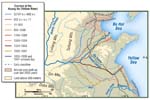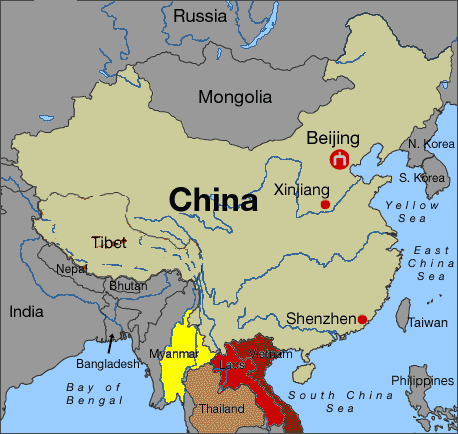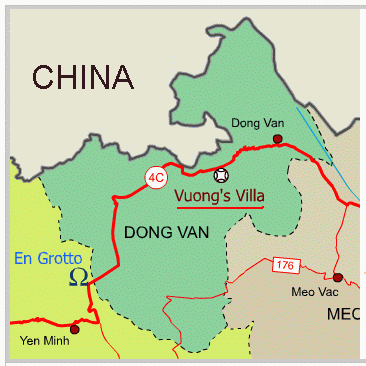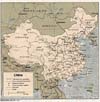 3.000 BC. There were 2 tribes in the Huang He River basin, in China: One’s major was cultivation, and the other was pastured breeding. 3.000 BC. There were 2 tribes in the Huang He River basin, in China: One’s major was cultivation, and the other was pastured breeding. |
| The cultivation tribe based on their major of living, named themselves Miao, written as |
| The breeding tribe is the Han |
The reasons for the Han- Miao wars
| The Miao tribe contended for cultivating grounds, while the Han tribe contended for breeding grounds. This was the original reason for the Han-Miao War in the Huang He River basin, China, lasting for thousands of years in Chinese History. |
| In the very 1st battle of Miao-Han, Xyooj Vwj led the Miao tribe, and Hao Yuan led the Han tribe. In this battle, Hao Yuan and his Han tribes defeated the Miao tribe out of the Huang He River basin, down to the South quote of the Huang He River. |
| Hieu Vien professed himself as emperor, he was the first king of the Han - Han Yan Dì. |
Miao Kingdom time.
| When Xyooj Vwj died, Yaj Lauj continued leading Miao against Han. Yaj Lauj had an adopted son who was a Han; without knowing that this adopted son was an agent. Han thrashed Yaj Lauj and dispersed Miao. The Miao lost their Three Miao kingdom since. |
| After losing the Three Miao kingdom, Han drove Miao to NanLing Shan to isolate and kill all Miao. That’s why Nan Ling Shan was named Miao Ling Shan then. It was a chain of high rocky mountains in the center of Hua Zhong. There where “3 days without sunlight, the ground without 3 even steps”. The Miao couldn’t stand there any longer and was trying to find a way out of Miao Ling Shan. |
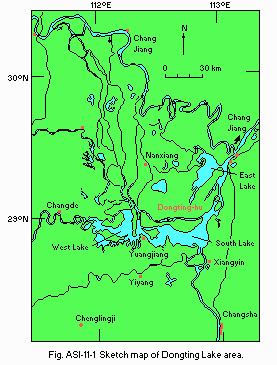 Not until the battlefield was filled with Miao’s bones, the Miao was able to get out of Han’s stranglehold, withdraw to Dong Ting Hu ( Not until the battlefield was filled with Miao’s bones, the Miao was able to get out of Han’s stranglehold, withdraw to Dong Ting Hu ( |
Dong Zhou Time
 Wo Qi headed a troop of 20,000 accessed Dong Ting Hu. The Miao was knocked off, once again, and withdrew deeply to the Hu Nan area, against the Han dynasties. Wo Qi headed a troop of 20,000 accessed Dong Ting Hu. The Miao was knocked off, once again, and withdrew deeply to the Hu Nan area, against the Han dynasties. |
| (Ma Tian Qiu, Ethnic Publishing House, Hu Nan, 1957, written in his book: “...Chang Sha city, Hu Nan’s metropolis, used to be resistant capital of the Miao for many times in the past, in their fighting against Han dynasties...” ) |
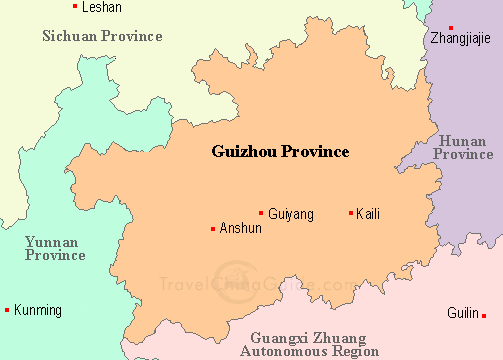 Gradually Hu Nan fell, the Miao receded to GuiZhou, and established Qian nation resisting Han kings. Thence, Gui Yang was the Miao nation’s metropolitan. Gradually Hu Nan fell, the Miao receded to GuiZhou, and established Qian nation resisting Han kings. Thence, Gui Yang was the Miao nation’s metropolitan. |
17th Century (during the Qing Dynasty of China)
| The Qian nation of Miao was exterminated by the Qing Dynasty of China. The last Miao king was Chaj Xaub Mim, killed by the Qing. His grave is located in the center of Gui Yang City, Gui Zhou province now. (China’s government allows all Miao in China to visit King Chaj Xaub Mim every year.) |
the Hmong has been a branch of the Miao nation since this time.
| For the last king Chaj Xaub Mim fell, the Miao has fallen apart since then: |
|
A branch was in West Hu Nan. Some were in Gui Zhou. Some lived along the border of Si Chuan- Yun Nan. Others live on the border of Gui Zhou- Guang Xi. Another lived in the South of Yun Nan. |
| The name Hmong appeared since this separation, objecting to the part of Miao whose name is Hmong. |
Paj Tawg Laj(Kai Huā Dai)
| The branch of Hmong who lived in the South of Yun Nan built a castle named Paj Tawg Laj, which means Blooming Flower Wall, in Chinese is Kai Hua Dai. Here they continued their fighting against the Qing dynasty. |
| In the middle of the Qing dynasty, the Miao was defeated. Qing dynasty occupied Kai Hua Dai and changed its name to Kai Húa Dai, which means Civilized Wall (homonym). |
| Until late of the late Qing dynasty, the Hmong were continuously beset and killed. The 17th century saw the enormous evacuation of the Hmong out of China. Hmong were scattered to nearby Southern China countries: the border of Myanmar and China, the border of Laos – China, the border of Viet Nam – China... |
| Our Hmong Vang was one among all of the Hmong clans who ran out of the slaughter. We use 7 rotational middle names for each generation to count how many times our generation’s repeated Each generation has 25 divisional years. Every 4 generations equals to 100 years. |
| At that time, our forefathers were in the Quynh (Jing) middle name. In that battle, our forefathers died, and there were only their 6 sons alive. All 6 brothers guarded each other on the getaway, the youngest brother was so young that the other brothers had to take him into the back basket (?pob tawb?) on their way fleeing to the North East of Viet Nam, at the border zone of Viet Nam and China. The sixth brother is in the Duy (Vim/Yin) middle name. Our branch is from the youngest brother Vaj Nkauj Lwb. (details on the family tree page) |
Early of 18th Century
| Vaj Txiab Ntawv turned back to Paj Tawg Laj which had now changed to the new name Kai Húa Dai. There he attended Chinese schools. After graduating from China, Vaj Txiab Ntawv came back to Dong Penh, Hu Yang. He worked as an Office Manager for Xyooj Tsw Dag, the Hmong king in Hu Yang at that time.(Xyooj Tsw Dag revolted against the Qing dynasty.) |
| Vaj Txiab Ntawv escaped to Pa Pu Mountain, Ma Li Po, Wen Shan, Yunnan, China. There he got married to a Hmong Lee clan's daughter. Until all things were safe and sound, they turned back to Sa Phin village, and lived in the Bear Cave, deeply in the jungle. |
Vaj Txiab Ntawv’s grave is still in Sa Phin village now, near our stone house. Vaj Txiab Ntawv had 2 sons, Vaj Tsas Pov and Vaj Zoov Looj. Vaj Zoov Looj was born on August 12th, 1865.
|

